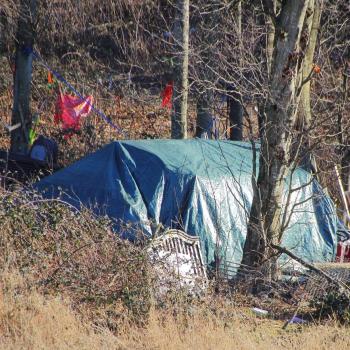Commentary: Follow the Veterans to End Homelessness in Vermont

This commentary by staff attorney Maryellen Griffin appeared in VTDigger on December 9, 2024.
Homelessness in Vermont has tripled since 2020. By contrast, veterans’ homelessness has been cut in half across the country since 2010, through a consistent, strategic effort led by the Department of Veterans Affairs.
I regularly hear people say with exasperation that homelessness in Vermont is a terrible problem, but there is nothing we can do. That is just not true. Vermont can and should cut homelessness by following the policies the VA has used. Those strategies have worked for veterans, and they will work in Vermont.
There are three key parts to the VA strategy:
A commitment to housing everyone who is homeless
The VA has had a consistent commitment to the housing first approach, and this has been a cornerstone of their success. Housing first means moving people to stable housing first, and then providing service and supports to address whatever problems they’re dealing with. People can most successfully address underlying challenges (such as substance use disorder and mental illness) when they are safely in housing and their autonomy is respected. Decades of research shows this approach works to improve outcomes and end homelessness.
Vermont has not done this. Vermont has had a hodgepodge approach to offering underfunded services and limited shelter to select groups of people, and that has just not worked.
A housing first system requires a statewide commitment to housing everyone and offering real support services to everyone. In other words, you don’t have to prove you’re worthy before you can get housed. Pathways Vermont has been housing people through a housing first approach for over a decade, so we have some homegrown expertise we could rely on to move our system in that direction. But we need leadership from the governor and the Legislature to commit to using that approach throughout Vermont.
Access to permanent affordable housing, particularly for people with disabilities
In our housing system as it now stands, it is really difficult to get any kind of affordable housing if you have ever been evicted, have some criminal history, or have a disability that affects your behavior. This is keeping a lot of people homeless.
The shortage of accessible housing is also very expensive. Bouncing people with serious mental illness between the streets and hospitals and the criminal justice system wastes a lot of taxpayer money. One study out of Florida estimated that the annual cost of a punitive approach to homelessness — enforcing anti-panhandling laws, maintaining hostile architecture and conducting police raids of homeless encampments — was three times higher than what supportive housing would cost. And that doesn’t even count the costs of emergency room use, hospitalization, incarceration, childhood trauma, lost education and work, and lost lives.
To end homelessness in Vermont, we need housing that is both affordable and accessible to everyone. Accessible does not just mean wide doorways. It means supportive housing where everyone, even people with a history of eviction or disabilities that impact their behavior, can get and keep a home.
Developing and supporting a skilled workforce
Vermont is paying an out-of-state for-profit company to hire temporary shelter team members at $107.50 an hour and temporary “program managers” at $325 an hour. This makes no sense. Instead of squandering public resources in this way, Vermont should commit to creating a real career path for Vermonters to do housing support work — continuing education and training, career advancement opportunities and a decent salary.
The approach Vermont is using to end homelessness is not working. A series of temporary programs, without a long-term commitment to developing policies that work, just keeps us in a neverending crisis.
People continue to cycle through homelessness, unstable housing, incarceration and hospitalization, at great cost to themselves, their families and their communities. Of the 532 people who became homeless in October, 232 had been homeless before, and 110 had been in “permanent” housing. Putting people into housing that is not affordable and not supported just sets people up to fail and is a waste of public resources.
Adopting a housing first approach as a statewide strategy would be a better use of public money and be better for the human beings caught in this whirlpool. We need to keep supporting temporary shelters while we create the permanent housing we need. That takes years, and no one wants people to die in tents while they wait for housing to come available.
But we need to make a much bigger commitment to funding supportive housing that is both affordable and accessible to all, and we need to pay and support Vermonters to do the social work needed to help people get and keep stable housing. In this way, we can save lives while also saving taxpayer dollars, improving public safety and health and helping our downtowns thrive.